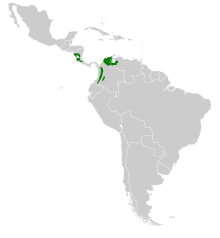Steely-vented hummingbird
The steely-vented hummingbird (Saucerottia saucerottei) is a medium-sized hummingbird that is a resident breeder from Colombia and northwestern Venezuela. The Central American birds differ in voice and behaviour from those in South America and may be a separate species, the blue-vented hummingbird (S. hoffmanni).
| Steely-vented hummingbird | |
|---|---|
_1.jpg) | |
| Scientific classification | |
| Kingdom: | Animalia |
| Phylum: | Chordata |
| Class: | Aves |
| Order: | Apodiformes |
| Family: | Trochilidae |
| Genus: | Saucerottia |
| Species: | S. saucerottei |
| Binomial name | |
| Saucerottia saucerottei | |
 | |
| Range of S. saucerrottei Year-round range | |
| Synonyms | |
|
Saucerottia saucerrottei | |
This hummingbird inhabits open woodland such as second growth, coffee plantations, gardens, savanna, and the edges and gaps of evergreen forests. It occurs from sea level up to 1,800 m (5,900 ft).
The nest is a cup of plant down and cobwebs, decorated outside with lichen and placed on a small outside twig 2–7 m (6.6–23.0 ft) high in a small tree. The female alone incubates the two white eggs.
The steely-vented hummingbird is 9 cm (3.5 in) long and weighs 4.5 g (0.16 oz). It is mainly bronze-green above, becoming more bronze on the wing, lower back and rump, and has a blue-black tail. The male has glittering green underparts, white thighs and a blue vent. The female is duller green below and has grey-buff edges to the vent feathers. Young birds are dull dark bronze-green below.
The steely-vented hummingbird has a trilled descending chit call in South America, but the Blue-vented from Central America has a high sharp tsip. The male's song in Costa Rica is a buzzy bzz WEEP wup.
This hummingbird feeds at many types of flowers, including epiphytes and Heliconias, and both sexes are aggressive and territorial, defending favoured areas.
References
- BirdLife International (2012). "Amazilia saucerrottei". IUCN Red List of Threatened Species. 2012. Retrieved 26 November 2013.CS1 maint: ref=harv (link)
- Stiles, F. Gary; Skutch, Alexander F. (1989). A Guide to the Birds of Costa Rica. Comstock Publishing Associates. ISBN 0-8014-9600-4.
- Hilty, Steven L. (2003). Birds of Venezuela. Princeton University Press. ISBN 0-7136-6418-5.
External links
| Wikimedia Commons has media related to Amazilia saucerrottei. |
| Wikispecies has information related to Amazilia saucerrottei |
- "Amazilia saucerrottei". Avibase.

- "Steely-vented hummingbird media". Internet Bird Collection.
- Steely-vented hummingbird photo gallery at VIREO (Drexel University)
- Steely-vented hummingbird species account at Neotropical Birds (Cornell Lab of Ornithology)
